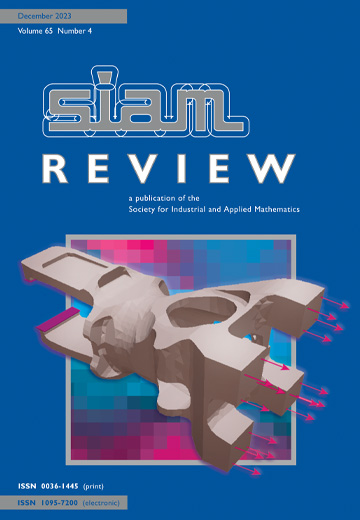Education
IF 6.1
1区 数学
Q1 MATHEMATICS, APPLIED
引用次数: 0
Abstract
SIAM Review, Volume 66, Issue 3, Page 573-573, May 2024.In this issue the Education section presents “Combinatorial and Hodge Laplacians: Similarities and Differences,” by Emily Ribando-Gros, Rui Wang, Jiahui Chen, Yiying Tong, and Guo-Wei Wei. Combinatorial Laplacians and their spectra are important tools in the study of molecular stability, electrical networks, neuroscience, deep learning, signal processing, etc. The continuous Hodge Laplacian allows one, in some cases, to generate an unknown shape from only its Laplacian spectrum. In particular, both combinatorial Laplacians and continuous Hodge Laplacian are useful in describing the topology of data; see, for instance, [L.-H. Lim, “Hodge Laplacians on graphs,” SIAM Rev., 62 (2020), pp. 685--715]. Since nowadays computations frequently involve these Laplacians, it is important to have a good understanding of the differences and relations between them. Indeed, though the Hodge Laplacian and the combinatorial Laplacian share similarities in revealing the topological dimension and geometric shape of data, at the same time they are intrinsically different in their domains of definitions and applicability to specific data formats. To facilitate comparisons, the authors introduce boundary-induced graph (BIG) Laplacians, the purpose of which is “to put the combinatorial Laplacians and Hodge Laplacian on equal footing.” BIG Laplacian brings, in fact, the combinatorial Laplacian closer to the continuous Hodge Laplacian. In this paper similarities and differences between combinatorial Laplacian, BIG Laplacian, and Hodge Laplacian are examined. Some elements of spectral analysis related to topological data analysis (TDA) are also provided. TDA and connected ideas have recently gained a lot of interest, and so this paper is timely. It is written in a way that should make it accessible for early career researchers; the reader should already have a good understanding of some notions of graph theory, spectral geometry, differential geometry, and algebraic topology. The paper is not self-contained and eventually could be used by group-based research projects in a Master's program for advanced mathematics students.
教育
SIAM Review》,第 66 卷第 3 期,第 573-573 页,2024 年 5 月。 本期教育版块将介绍 Emily Ribando-Gros、Rui Wang、Jiahui Chen、Yiying Tong 合著的 "Combinatorial and Hodge Laplacians:由 Emily Ribando-Gros、Rui Wang、Jiahui Chen、Yiying Tong 和 Guo-Wei Wei 合著。组合拉普拉斯及其谱是研究分子稳定性、电网络、神经科学、深度学习、信号处理等的重要工具。连续霍奇拉普拉斯在某些情况下允许人们仅从其拉普拉斯谱生成未知形状。特别是,组合拉普拉斯和连续霍奇拉普拉斯在描述数据拓扑时都很有用;例如,请参阅 [L.-H. Lim, "Hodge Laplacians on graphs," SIAM Rev., 62 (2020), pp.]由于现在的计算经常涉及这些拉普拉斯,因此很有必要充分了解它们之间的区别和关系。事实上,虽然霍奇拉普拉斯和组合拉普拉斯在揭示数据的拓扑维度和几何形状方面有相似之处,但它们在定义域和对特定数据格式的适用性方面却有本质区别。为了便于比较,作者引入了边界诱导图(BIG)拉普拉斯,其目的是 "将组合拉普拉斯和霍奇拉普拉斯置于同等地位"。事实上,BIG 拉普拉斯使组合拉普拉斯更接近连续霍奇拉普拉斯。本文研究了组合拉普拉齐、BIG 拉普拉齐和霍奇拉普拉齐之间的异同。本文还提供了与拓扑数据分析(TDA)相关的光谱分析的一些要素。拓扑数据分析(TDA)及其相关思想最近受到了广泛关注,因此这篇论文非常及时。这篇论文的写作方式应该能让职业生涯初期的研究人员读懂;读者应该已经对图论、谱几何、微分几何和代数拓扑学的一些概念有了很好的理解。本文并非自成体系,最终可用于高等数学硕士课程中以小组为基础的研究项目。
本文章由计算机程序翻译,如有差异,请以英文原文为准。
求助全文
约1分钟内获得全文
求助全文
来源期刊

SIAM Review
数学-应用数学
CiteScore
16.90
自引率
0.00%
发文量
50
期刊介绍:
Survey and Review feature papers that provide an integrative and current viewpoint on important topics in applied or computational mathematics and scientific computing. These papers aim to offer a comprehensive perspective on the subject matter.
Research Spotlights publish concise research papers in applied and computational mathematics that are of interest to a wide range of readers in SIAM Review. The papers in this section present innovative ideas that are clearly explained and motivated. They stand out from regular publications in specific SIAM journals due to their accessibility and potential for widespread and long-lasting influence.
 求助内容:
求助内容: 应助结果提醒方式:
应助结果提醒方式:


